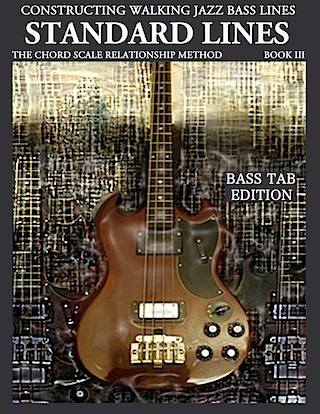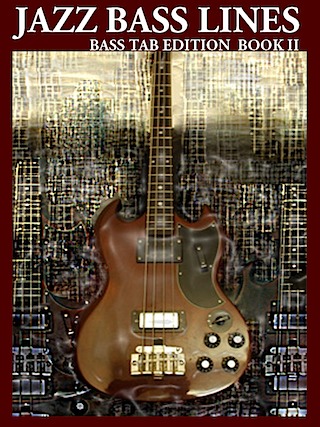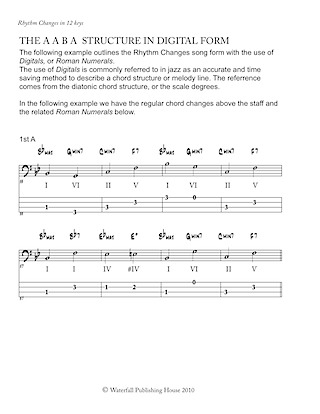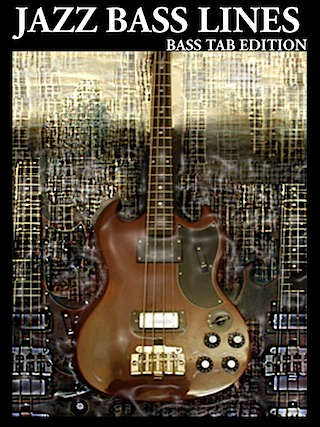STANDARD LINES The Chord Scale relationship method
Book III in the Constructing Walking Jazz Bass Lines
Series. For the ELECTRIC BASSIST
Bass Tab Edition.

FOREWARD
Standard Lines Book III in the Constructing Walking Jazz Bass
Lines series for the Electric Bassist is a
comprehensive guide demonstrating the devices used to construct
walking jazz bass lines in the jazz standard tradition.
Book III covers 24 standard jazz chord progressions with 110 choruses
of professional jazz bass lines as an example.
Part I outlines the Modes and the chord scale relationships and the
fundamental knowledge required to be able to build the diatonic triads
and 7th chords in any key. Examples are given in the " 2 " feel and " 4 "
feel walking bass style enabling the bassist to develop a strong
rhythmic and harmonic foundation.
More advanced bass line construction examples including voice
leading and mode substitutions and mode applications related to specific
jazz chord progressions are also outlined.
Part II outlines the Symmetric Scales as well as the Modes of the
Melodic Minor Scale related to the Minor II V I progression.
Provided are written examples of the Symmetric Scales and the chord
scale relationships and how to apply the use of the Symmetric Scales
over popular jazz chord progressions.
The Minor II V I is outlined and compared to the Major II V I
outlining the differences with the suggested scale uses applied to
common jazz chord progressions.
Part III outlines the use of the BeBop Scales and their use in the jazz
walking bass tradition, providing suggested uses of the Be Bop scales
related to popular jazz chord progressions.
Part IV outlines the previous lesson devices and concepts with
examples of professional level bass lines over standard jazz chord
progressions.
All information builds in a stepwise progression enabling the bassist to
apply the techniques in all 12 keys.
TABLE OF CONTENTS
Part 1
The Chord Scale Relationships .....................................................
How to apply the Modes and chord scale relationships to
standard chord progressions...........................................................
How to construct the triads off of the major scale .........................
Jazz chord progression # 1 " Periodic "
Bass Line Construction Triads and the " 2 " feel ...........................
Triads " 4 " feel walking bass line .................................................
Triads and the chromatic approach from above .............................
Triads and the chromatic approach from below .............................
Triads and the Walk Up ................................................................
Triads and the Walk Down ...........................................................
Jazz chord progression # 2 " Greatest Glove "
Scalar approaches to constructing bass lines " ascending " .............
Applying 7th chords to scalar bass lines
How to construct the diatonic 7ths ...............................................
Applying 7th chords to scalar bass lines " descending "..................
Ascending scalar with chromatic approach from above .................
Descending scalar with chromatic approach from below ...............
Voice leading 7th chords & the II V I progression ........................
Jazz chord progression # 3 " Winters Coming "
Applying the voice leading technique to bass lines ........................
Voice leading the Dominant 7th chord .........................................
How to apply the Modes to constructing walking jazz bass lines
The Ionian mode .........................................................................
Jazz chord progression # 4 " Mr. K " .............................................
The Major II V I progression and the the Dorian &
Mixolydian modes .......................................................................
The II V I progression .................................................................
The application of the II V I progression in jazz chord
progressions .................................................................................
The III VI II V progression and the Phyrgian mode .....................
The III VI II V I progression ......................................................
The application of the III VI II V I progression in jazz
chord progressions .......................................................................
The I VI II V progression and the Aeolian mode .........................
The application of the I VI II V progression in jazz
chord progressions .......................................................................
The Lydian mode .........................................................................
Jazz chord progression # 5 " It Depends "
Applying the Lydian Mode to constructing jazz bass lines ............
The Locrian Mode .......................................................................
Jazz chord progression # 6 " The Weaving Stream " ....................
Applying the Locrian Mode to constructing jazz bass lines ..........
Part II
Symmetric & Melodic Minor Scales ............................................
The Whole Tone scale
Jazz chord progression # 7 " Wheres the subway ? " ....................
The Diminished scale ..................................................................
Jazz chord progression # 8 " Finding Candy "
Applying the use of the Diminished scale .....................................
The Half Whole Diminished scale ...............................................
Jazz chord progression # 9 " Vegetable Stew "
Applying the use of the Half Whole Diminished scale .................
The Diminished Whole Tone scale & the
Minor II V progression ...............................................................
Jazz chord progression # 10 " Moonlight View "
Applying the use of the diminished whole tone scale ....................
The Locrian # 2 & the Minor II V progression ...........................
Applying the use of the Locrian # 2 scale .....................................
The Minor II V progression .........................................................
Part III
The Bebop Scales
The ascending Major Bebop scale .................................................
The descending Major Bebop scale ...............................................
Jazz chord progression # 11 " More Stew ? "
Applying the use of the Major Bebop scale ...................................
The ascending Dorian minor Bebop scale .....................................
The descending Dorian minor Bebop scale ...................................
Jazz chord progression # 12 " Heard It "
Applying the use of the Dorian Minor bebop Scale ......................
The ascending Mixolydian Bebop scale .........................................
The descending Mixolydian Bebop scale .......................................
Jazz chord progression # 13 " Who's Glove ? "
Applying the use of the Mixolydian Bebop Scale ..........................
Part IV Jazz Bass Line examples over standard Jazz
chord progressions .......................................................................
Jazz chord progression # 14 " Ocean St " ....................................
Jazz chord progression # 15 " Slipped into the Stream " ..............
Jazz chord progression # 16 " Only You " ....................................
Jazz chord progression # 17 " The One in Gloves " ...................
Jazz chord progression # 18 " Garden Hoses " ...........................
Jazz chord progression # 19 " Who Are You ? " .........................
Jazz chord progression # 20 " Idiosyncrasy "...............................
Jazz chord progression # 21 " The Third " .................................
Jazz chord progression # 22 " New Gloves " ..............................
Jazz chord progression # 23 " Bring Your Strings " ....................
Jazz chord progression # 24 " No Ones Here " ..........................
In Conclusion .............................................................................
BOOK I " CONSTRUCTING WALKING JAZZ BASS LINES - WALKING BASS LINES -THE BLUES IN 12 KEYS BASS TAB EDITION $15.95 ADOBE PDF FORMAT. AVAILABLE WORLDWIDE.
Walking bass guitar tab.
BOOKS ON BOARD $15.95 NOW $9.98
http://www.booksonboard.com/index.php?BODY=viewbook&BOOK=765702
CONSTRUCTING WALKING JAZZ BASS LINES BOOK I WALKING JAZZ BASS LINES - THE BLUES IN 12 KEYS BASS TAB EDITION The " CONSTRUCTING WALKING JAZZ BASS LINES " BASS TABLATURE series of books provides the same knowledge and wealth of information available to the bassist reading bass tab, as there would be for the bassist reading bass clef. The following series of books provides note for note analysis, bass lines and examples as they appear in the standard bass clef volume. The Blues in 12 Keys , Book I in the Constructing Walking Jazz Bass Lines series is designed to give the aspiring bassist of all levels the tools and devices required to construct professional level jazz bass lines and to build a strong functional awareness of how to function as a professional bassist in any musical setting. The information builds in a stepwise progression enabling the beginning to advanced bassist to gather the necessary tools required to find their own voice as a bassist. The Blues in 12 Keys is a complete guide demonstrating the devices used to construct walking bass lines in the jazz tradition. Part 1 by demonstrates the various techniques used to provide forward motion into bass lines, while providing a strong harmonic and rhythmic foundation. The exercises are designed to give the electric bassist strong jazz bass lines in the bottom register of the instrument. As an added bonus for the electric bassist Part 1 provides a complete study of the blues in F whilst in the first position. This is an excellent technique builder in itself. Part 2 expands on the lessons and techniques used in Part 1 providing the bassist with the previous devices used in professional level bass lines in all 12 keys. Included is over 150 choruses of jazz blues lines in all 12 keys using the whole register of the instrument. There are many advanced principles applied in the following bass lines whilst never losing sight of the functioning principle of the bass in the jazz idiom. To provide a strong foundation of rhythm and harmony. An additional area of interest for the electric bassist reading tab is the inclusion of the bass clef directly above the Bass Tab. This enables the bassist the option of applying their knowledge of tablature to the task of learning to read music. Suitable for bassists of all styles beginner to advanced level.
PART 1 The Blues in F
The " 2 " feel ............................................................................
The Jazz blues progression and the use of triads ..........................
Embellishing the " 2 " feel ......................................................
The Dominant 7th chord ........................................................
Chromatic approach from below ............................................
Chromatic approach from above .............................................
Chromaticism and the walk up
and the walk down ..................................................................
Repeated notes and chromaticism ............................................
Harmonic Anticipation and playing across the bar line .................
Voice leading 7th chords .........................................................
Pedal points .............................................................................
Tri-Tone substitution ..............................................................
The Turnaround .......................................................................
PART 2
Blues in F ................................................................................
Blues in Gb .............................................................................
Blues in G ...............................................................................
Blues in Ab .........................................................................
Blues in A ...........................................................................
Blues in Bb .........................................................................
Blues in B ...........................................................................
Blues in C ...........................................................................
Blues in Db ........................................................................
Blues in D ...........................................................................
Blues in Eb .........................................................................
Blues in E ...........................................................................
In Conclusion ......................................................................
BOOK II " CONSTRUCTING WALKING JAZZ BASS LINES - WALKING BASS LINES -RHYTHM CHANGES IN 12 KEYS BASS TAB EDITION $15.95
BOOKS ON BOARD $15.95 NOW $9.98
http://www.booksonboard.com/index.php?BODY=viewbook&BOOK=765704


Rhythm Changes in 12 Keys is Book II in the " Constructing Walking Jazz Bass Lines " series for the Electric Bassist. Rhythm Changes in 12 Keys compliments Book I " The Blues in 12 Keys " by following on with an in depth study of " must know " Jazz chord progressions for the aspiring Jazz Bassist. Rhythm Changes in 12 Keys is a complete guide demonstrating how to construct walking jazz bass lines in the jazz tradition. Part 1 of the book outlines and demonstrates the various techniques used by professional Jazz Bassists to provide forward motion and a strong harmonic and rhythmic foundation into bass lines. Part 2 of the book outlines Rhythm Changes in 12 keys with over 70 choruses of professional jazz bass lines. for Beginner to Advanced students.
Rhythm Changes in 12 Keys compliments Book I " The Blues in
12 Keys " by following on with an in depth study of " must know "
Jazz chord progressions for the aspiring Jazz Bassist.
Rhythm Changes in 12 Keys is a complete guide demonstrating the
devices used to construct walking jazz bass lines in the jazz tradition.
Part 1 of the book outlines and demonstrates the various
techniques used by professional Jazz Bassists to provide forward
motion and a strong harmonic and rhythmic foundation into bass
lines.
All exercises are designed to give the Electric Bassist strong
jazz bass lines in the bottom register of the instrument.
An additional bonus for the Electric Bassist, Part 1 provides a
complete study of Bb Rhythm Changes whilst in the first position.
This is an excellent technical study for building strength, improving
intonation and being able to walk strong bass lines at increased
tempos in the bottom register of the instrument.
Part 2 expands on the lessons and techniques used in Part 1
providing the aspiring Jazz Bassist with the previous devices used in
professional level bass lines in all 12 keys. Providing over 70 choruses
of Rhythm Changes in all 12 keys using the whole register of the
instrument. In total there are over 100 choruses of Rhythm Changes
included in Part I and Part II of this book.
There are many advanced principles applied in the following bass
lines whilst never losing sight of the functioning principle of the bass
in the jazz idiom. To provide a strong foundation of rhythm and
harmony for the music being played & providing support for the
melody and or soloist.
TABLE OF CONTENTS
Part 1 Rhythm Changes ..............................................................
The AABA Form .......................................................................
The AABA Structure in Digital Form ........................................
Diatonic 7ths in the key of Bb major .................................. .......
The "2" feel ................................................................................
Embellishing the "2" feel ...........................................................
The Dominant 7th chord ...........................................................
Chromatic approach from below ...............................................
Chromatic approach from above ................................................
Chromaticism and the walk up
and the walk down .....................................................................
Repeated notes and chromaticism ..............................................
Harmonic anticipation and
playing across the bar line ..........................................................
Voice leading and 7th chords .....................................................
Pedal points ................................................................................
Tri-Tone substitution .................................................................
Expanding on the use of Tri-Tone substitution ...........................
The Turnaround ...........................................................................
Turnarounds and the AABA Form .............................................
Rhythm Changes the "A" section progressions ...........................
Rhythm Changes the Bridge ......................................................
Secondary Dominant Chords ......................................................
Rhythm Changes the Bridge chord substitutions ........................
Part 2 Rhythm Changes in 12 Keys .......................................
Rhythm Changes in Bb ...........................................................
Rhythm Changes in B .............................................................
Rhythm Changes in C .............................................................
Rhythm Changes in Db ...........................................................
Rhythm Changes in D .............................................................
Rhythm Changes in Eb ...........................................................
Rhythm Changes in E .............................................................
Rhythm Changes in F ..............................................................
Rhythm Changes in Gb ...........................................................
Rhythm Changes in G .............................................................
Rhtyhm Changes in Ab ...........................................................
Rhythm Changes in A .............................................................
In Conclusion ..........................................................................
“looking at the examples, I can tell you that they will be very useful in learning these specifically important Jazz progressions in every key, which practically every Jazz teacher tells me I should do! My music theory training gives me enough insight to recognize that they will be very useful. The appearance and lay-out are comfortable to look-at, which makes it all easier to read; and I like the Jazz fonts! I am particularly pleased that all the examples are completely written-out note-for-note; whereas in many books by other authors, an example will be given in one key with the other keys being left up to the student to figure-out! I always found that to be extremely frustrating.
It's nice that you covered so many variations on the basic A part progression of Rhythm Changes, since that's the way the the song really gets played... and to write-out all the bass lines instead of just the chord symbols. This lets the student learn the actual melodic motion of bass lines in the way that they are really used. The use of scale-type phrases, chromatic lines, occasional wide interval leaps, and rhythmic variations (such as quarter-note triplets and dotted-eighth/sixteenth notes) ...all in context... really puts it all in proper perspective. It shows how those devices are actually used! That's the stuff people learn-from through specific examples! Then once the student gets the hang of it, one should be able to call on these ideas in increasingly improvisational and hence musical ways.”
Doug Seattle Washington USA
" bonjour,
i don't find book III .
i've already book one and two , i like it .
where i'll buy book III ?"
Lolowes 2002 France
" I should take you a picture of the
stack of bass books I have, but I have never been able to retain or
understand how lines are constructed, how modes work, etc. The progression
of information you are presenting has made very clear what has been a fog to
me for years, and I am excited to be opening the door I have been standing
in front of since I was a teenager. "
Jon Idaho USA
"I recently purchased Book I , it is the one I wanted. So I
am looking forward to being the Book II will be available.
I understand Book II will be released soon. Since I live in Japan, I hope
Book II will be available on Amazon.co.jp soon. "
Hideo Japan
" I recently purchased book II from amazom.co.jp, and it is also good book for me."
Hideo Japan
Steven Mooney
Waterfall Publishing House
www.Waterfallpublishinghouse.com
www.Constructingwalkingjazzbasslines.com
9780982957011, $19.95, www.amazon.com
"Constructing Walking Jazz Bass Lines, Book 1, The Blues in 12 Keys: A Comprehensive Guide To Constructing Walking Jazz Bass Lines for the Double Bassist and Electric Jazz Bassist" is a complete 12-key guide to techniques and devices used to construct walking jazz bass lines in the jazz tradition.
Part I, the Blues in F, presents exercises and techniques known to help create robust jazz bass lines, moving forward while retaining a solid rhythmic, harmonic foundation. Part 2, The Blues in 12 Keys, expands further the lessons of Part 1, providing previous techniques and devices used in professional level bass lines in all 12 keys. The practical and ambitious aim of "Constructing Walking Jazz Bass Lines" is "to give the aspiring bassist a solid grounding in understanding how to construct walking Jazz Bass lines and support a melody and or soloist (p. 97)." The Book concludes with sage advice, "Listen to as much music as you can, Listen to the masters (p.97)."
Included is full notations with enharmonic chord symbols for more than 150 choruses of jazz blues lines in all 12 keys, using the whole register of the instrument. "Constructing Walking Jazz Bass Lines Book 1" is an invaluable resource to the aspiring jazz bassist, with potential for learning teaching and great practical application.
Also recommended in this series by the same author is: "Constructing Walking Jazz Bass Lines, Rhythm Changes in 12 Keys," ISBN 9780982957028, $19.95. Additionally recommended is "Constructive Walking Jazz Bass Lines Book II, Bass Tab Edition," ISBN 9780982957035, $19.95.
Customer Reviews
|
Part I, the Blues in F, presents exercises and techniques known to help create robust jazz bass lines, moving forward while retaining a solid rhythmic, harmonic foundation. Part 2, The Blues in 12 Keys, expands further the lessons of Part 1, providing previous techniques and devices used in professional level bass lines in all 12 keys. The practical and ambitious aim of "Constructing Walking Jazz Bass Lines" is "to give the aspiring bassist a solid grounding in understanding how to construct walking Jazz Bass lines and support a melody and or soloist (p. 97)." The Book concludes with sage advice, "Listen to as much music as you can, Listen to the masters (p.97)."
Included is full notations with enharmonic chord symbols for more than 150 choruses of jazz blues lines in all 12 keys, using the whole register of the instrument. "Constructing Walking Jazz Bass Lines Book 1" is an invaluable resource to the aspiring jazz bassist, with potential for learning teaching and great practical application.
An Essential Jazz Bassists Book,
This review is from: CONSTRUCTING WALKING JAZZ BASS LINES BOOK I WALKING BASS LINES: THE BLUES IN 12 KEYS (Paperback)
First of all, the title is a bit of a misnomer. Yes, there are transcriptions of Blues in all twelve keys. The transcriptions are 3 to 5 pages each. But what the beginning to intermediate bassist will find most usefull are the 33 pages, at the beginning of the book, demonstrating the various devices that Jazz Bassists use to construct effective bass lines. The Advanced player will welcome the books interesting exercises to use for keeping the chops up. Steven Moody, the author, guides the reader through exercises including Chromatic Approaches, Dominant 7th Chords, Harmonic anticipation, Voice leading tones, and Tri-Tone Substitution. Mr. Moody's book gives clearly written directions of the various techniques,followed by bass clef progressions that detail the examples. All the examples are interesting and go beyond the usual straight 4 beats to the bar that unfortunately fill up many of the books that I've purchased. I can see that this book will end up as dog-eared and ragged as my copy of Simandl, from repeated use.

|


